If you don’t record audio, it’s easy to think you don’t need an audio interface for music production.
Did you know audio interfaces improve playback quality as well?
That’s right.
Audio interfaces are not just for connecting your devices.
They play a significant role in improving sound quality.
If you thought about skipping out on buying an audio interface, here are three reasons why you should consider buying one.
Overview
Yes, there are 3 main reasons why an audio interface is helpful for music production.
- Audio interfaces improve playback quality on studio monitors and headphones, leading to better mixes.
- Interfaces improve recording quality when recording guitar and other instruments.
- You can use an audio interface to record high-quality samples (i.e., drums, percussion, vocal chops, etc.) through a condenser mic.
In general, audio interfaces process high-quality audio.
Any audio going in and out of your computer should go through an audio interface first.
Here are more details on why…
3 Reasons Why you Need an Audio Interface for Music Production?
1. Better Quality Playback through Studio Monitors and Headphones
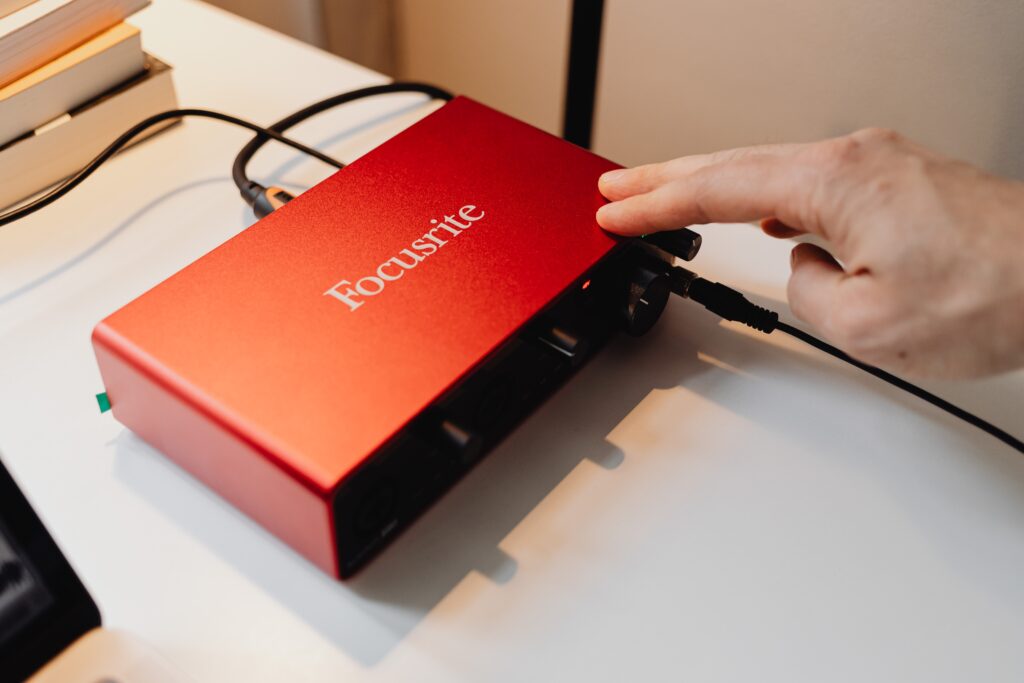
Using an audio interface helps improve your mixes.
How?
Connecting your studio monitors and headphones to your computer through an audio interface will give you the best quality playback.
In general, mixing involves cutting and boosting frequencies, adding reverb, compression, etc.
You’ll need to make subtle changes based on what you hear through your listening devices.
It’s not enough to have quality monitors and headphones. How you connect them to your computer is just as important.
To understand why you need an audio interface, it’s crucial to know how they process sound in music production.
What’s a Sound Card?
Computers don’t understand audio signals.
Your computer stores any audio you produce in a digital format.
For your computer to produce sound, it needs a sound card to convert digital audio data into analog signals (sound waves) – using a digital-to-analog converter (D/A).
As a result, what you hear during playback is a product of the D/A conversion process.
The goal of an audio interface is to convert digital data to audio signals while maintaining accuracy and clarity.
Why you Should Always Use an Audio Interface for Mixing
Your computer also has a sound card with a D/A converter.
What’s wrong with connecting your monitors and headphone directly to your computer?
Audio interfaces have better D/A converters than computers.
Computers have many other functions, while audio interfaces specialize in audio production and playback.
As a result, the sound you hear through your outputs will be more accurate with an audio interface.
To learn more about how audio interfaces benefit mixing, check out this post.
Here we go in-depth on how audio interfaces improve sound quality by having I/O with flat frequency responses. And high-resolution audio converters with high max bit-depth and sample rates.
Does an Audio Interface Really Make a Difference if you Have Quality Speakers and Headphones?
In music production, several factors contribute to maximizing your sound quality.
An acoustically treated room and high-quality equipment will help.
But at a basic level, an audio interface will process your sound as cleanly as possible.
Combining these sound-improving methods gives you the best representation of your audio.
Ultimately, having a high-quality audio interface can help you make informed mixing decisions.
2. Audio Interfaces Improve Recording Quality in Music Production

Connecting your guitar or other instruments through an audio interface will improve your recording quality.
Why?
Another job of a sound card is to convert analog signals to digital signals through an analog-to-digital (A/D) converter.
Remember how I said computers don’t understand audio signals, only digital?
Well, an A/D converter converts sound waves into data that your computer can understand.
Audio interfaces have better A/D converters than other recording devices – computers, phones, and tablets.
As a result, they can capture different audio frequencies more accurately and precisely.
The benefits of using an audio interface don’t stop there…
Preamps
Audio interfaces tend to have great preamps for home recording.
What’s a preamp, and why is it necessary when recording audio?
Guitars and microphones produce audio signals below the necessary level for recording.
The proper recording level is around +4dB, also known as “line level.”
Generally, audio interface preamps are great at adding gain to signals without introducing unwanted noise.
[Check out the audio interface with the best preamps]
3. Record Original Samples
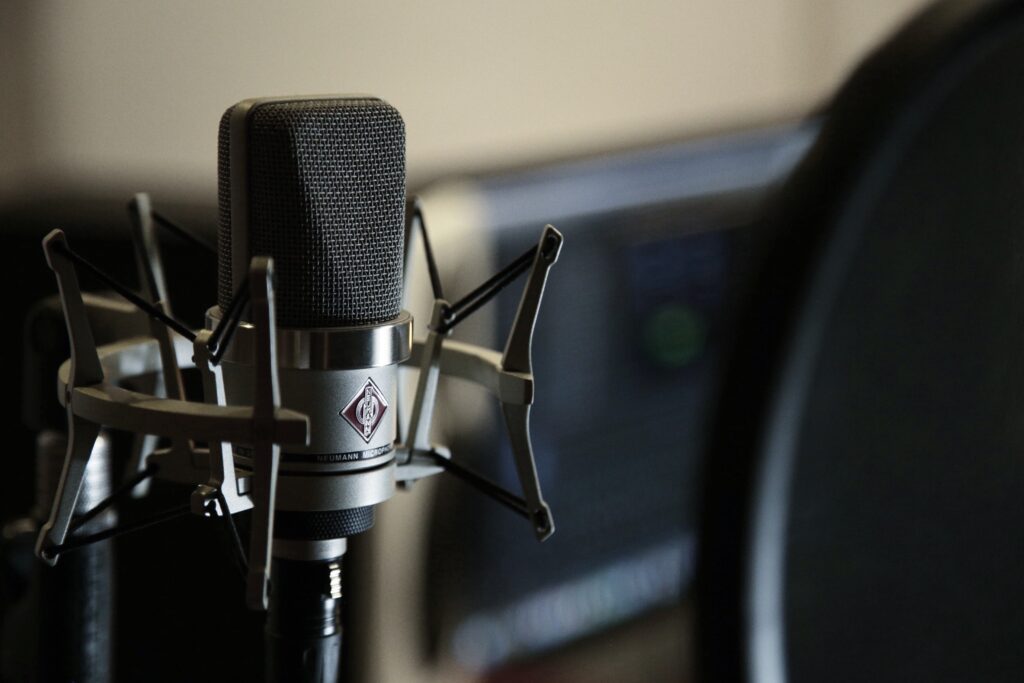
The final reason you should use an audio interface for music production is for recording original samples.
Have you ever wanted to experiment with sound design?
There are a bunch of drum samples you can download online.
But how cool would it be to create your own samples?
It all starts with having a quality condenser mic.
From there, an audio interface can help you get the best quality sound from your mic.
You can create hi-hats, kick drums, percussion sounds, FX, and even risers by recording basic sounds.
Then you can add filters and effects to create something unique.
There’s no better way to stand out as a producer than using original sounds.
You can also spice up your production by creating your own vocal chops or producer tag.
In general, having an audio interface in your home studio adds flexibility to your production process.
What to Look for in an Audio Interface for Music Production?
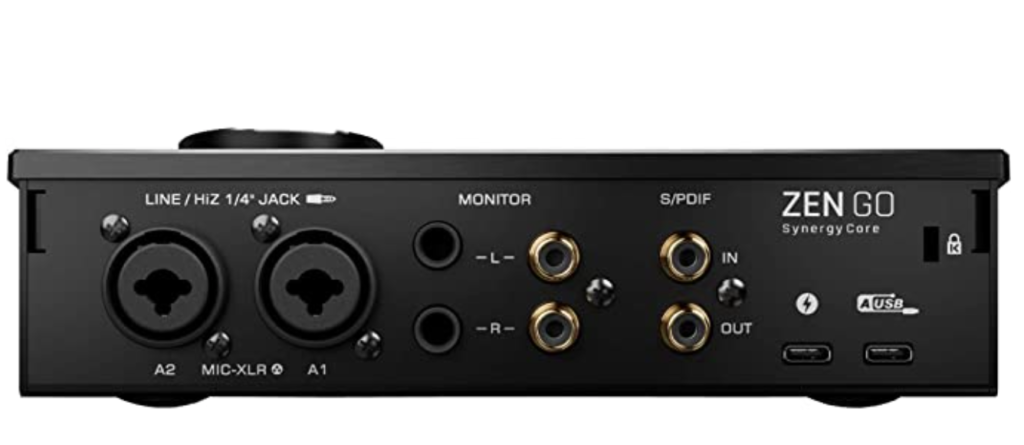
Type of Connection: Thunderbolt, USB, and Firewire Audio Interfaces
Audio interfaces have three primary connection types; Thunderbolt, USB, and Firewire.
Thunderbolt
Many high-end audio interfaces support Thunderbolt connection – known for its high speed and low latency.
Thunderbolt 3 reportedly transfers data eight times faster than USB 3.
USB
Budget audio interfaces tend to use a USB connection.
There are three different versions of USB – 1.0, 2.0, and 3.0.
The higher the number, the faster the data transfer rate.
Firewire
Firewire connection is less common than Thunderbolt and USB.
However, it’s known to be more reliable than USB when recording multiple channels at once.
Inputs and Outputs (I/O)
An audio interface with 2-4 inputs and the same number of outputs is ideal.
This will give you enough inputs to connect a mic and guitar if needed.
An interface with MIDI ports is also helpful if you’re using an older keyboard or synth.
Software and Equipment Bundle
Are you just getting started in music production? Feeling overwhelmed by all the equipment you need?
Consider purchasing a recording kit.
Some kits come with headphones, speakers, software, and an audio interface – everything you need for a basic recording setup.
You won’t be getting the best quality equipment, but it’s enough to get started.
Here are two recording kits we recommend:
PreSonus AudioBox 96 Studio Plus Recording Kit
Focusrite Scarlett 2i2 2×2 Audio Interface Full Studio Bundle
What’s the Best Audio Interface for Beginner Producers?
There are plenty of great audio interfaces for beginners.
But one of the most popular is the Focusrite Scarlett 2i2 3rd Gen.
Focusrite Scarlett 2i2 3rd Gen
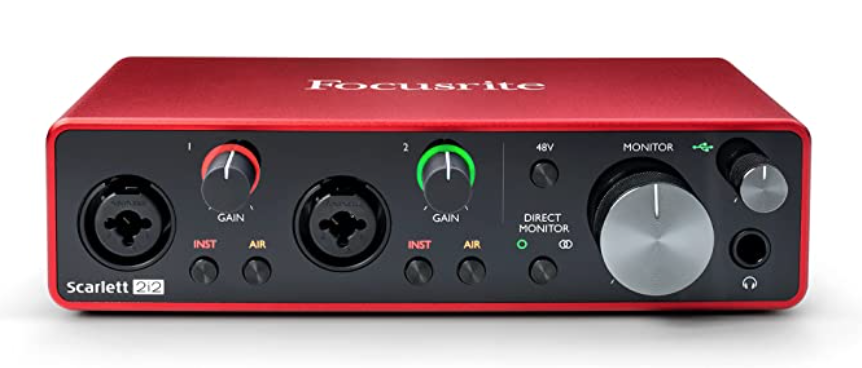
Features
- 2 combo mic, instrument, and line inputs | 2 balanced outputs
- High-quality low-noise transparent preamps
- High-resolution audio – 24-bit/192 kHz
- Direct monitoring (in mono and stereo) – lets you hear near-zero latency audio directly from your mic or instrument
- Halo LED recording level meters
- Intuitive design with large, spaced-out, well-placed knobs – easy to navigate
Reasons to Buy
The Focusrite Scarlett 2i2 has a clean design making it super easy to use for beginners.
With the 2i2, you’ll get studio-quality I/O – with flat frequency responses and relatively high dynamic range.
It’ll also come with low-noise transparent preamps featuring Air Mode.
With Air Mode enabled, your audio will sound brighter and more open.
Overall, the 2i2 delivers professional sound quality with excellent features.
Here are 3 more budget interfaces that are great for beginner producers:
Native Instruments Komplete Audio 2
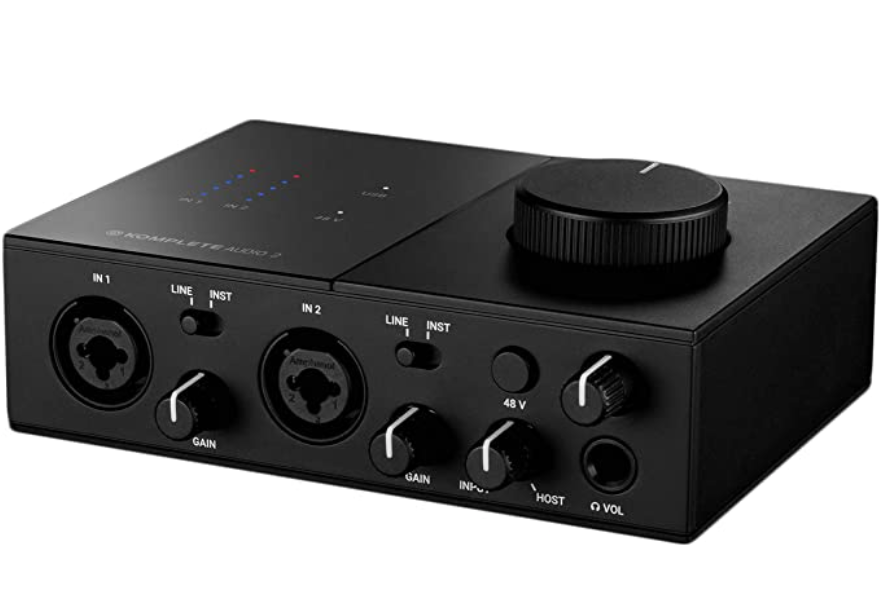
- 2 combo mic, line, and instrument inputs | 2 balanced outputs
- High resolution 24-bit/192 kHz
- VU Meter for accurately setting gain levels and monitoring clipping
- Direct monitoring blend knob (Input/Host) – lets you blend your direct signal and the signal from your DAW to control latency
- Minimalist design – easy navigate
[Check out our in-depth review on the NI Komplete Audio 1 & 2 here]
Motu M2
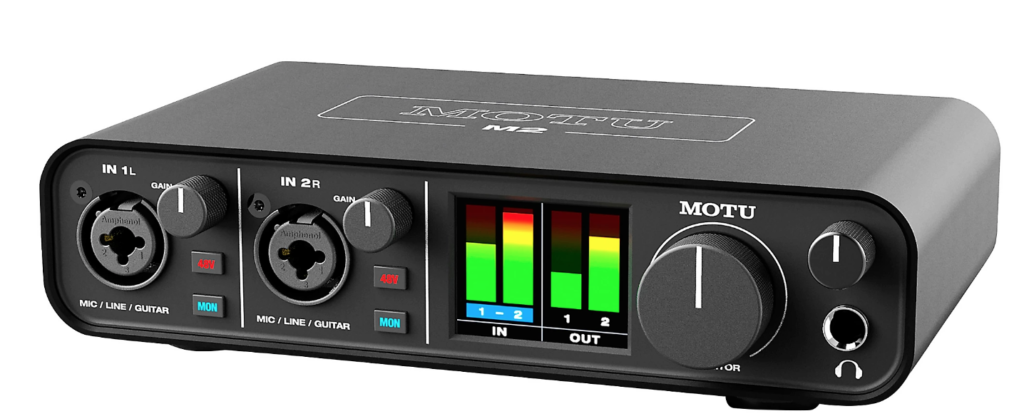
- 2 combo mic, line, and instrument inputs | 2 balanced outputs
- High resolution 24-bit/192 kHz
- Separate direct monitoring and phantom power buttons for each input
- Detailed LCD recording level meter
- Intuitive design with large, spaced-out, well-placed knobs – easy to navigate
[Here’s our full review on the Motu M2]
Behringer U-PHORIA UMC202HD Audiophile

- 2 combo mic, line, and instrument inputs | 2 balanced outputs
- High-resolution audio – 24-bit/192 kHz
- Direct monitoring
- Pad switch
- Simple design – easy to navigate
- LED indicators
[Check out our complete review of the Behringer UMC202HD here]
Takeaway: Do you Need an Audio Interface for Music Production?
In summary, music producers need an audio interface for three reasons:
1. An Audio Interface will Improve Playback Quality
High-quality playback will help you make better mixing decisions.
As a result, the sound quality of your productions will improve.
2. An Audio Interface will Improve Recording Quality
Analog sounds from instruments need to be converted to digital signals that can be understood by computers.
Audio interfaces generally have high-quality A/D converters that can do this without sacrificing sound quality.
3. An Audio Interface will Improve the Quality of your Samples
Even if your not recording vocals, you can use a condenser mic to record original samples.
These can be drum samples, vocal chops, or sound effects.
To optimize the quality of these samples, you’ll need to connect your mic through an audio interface.








